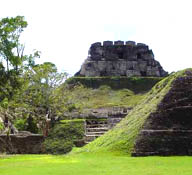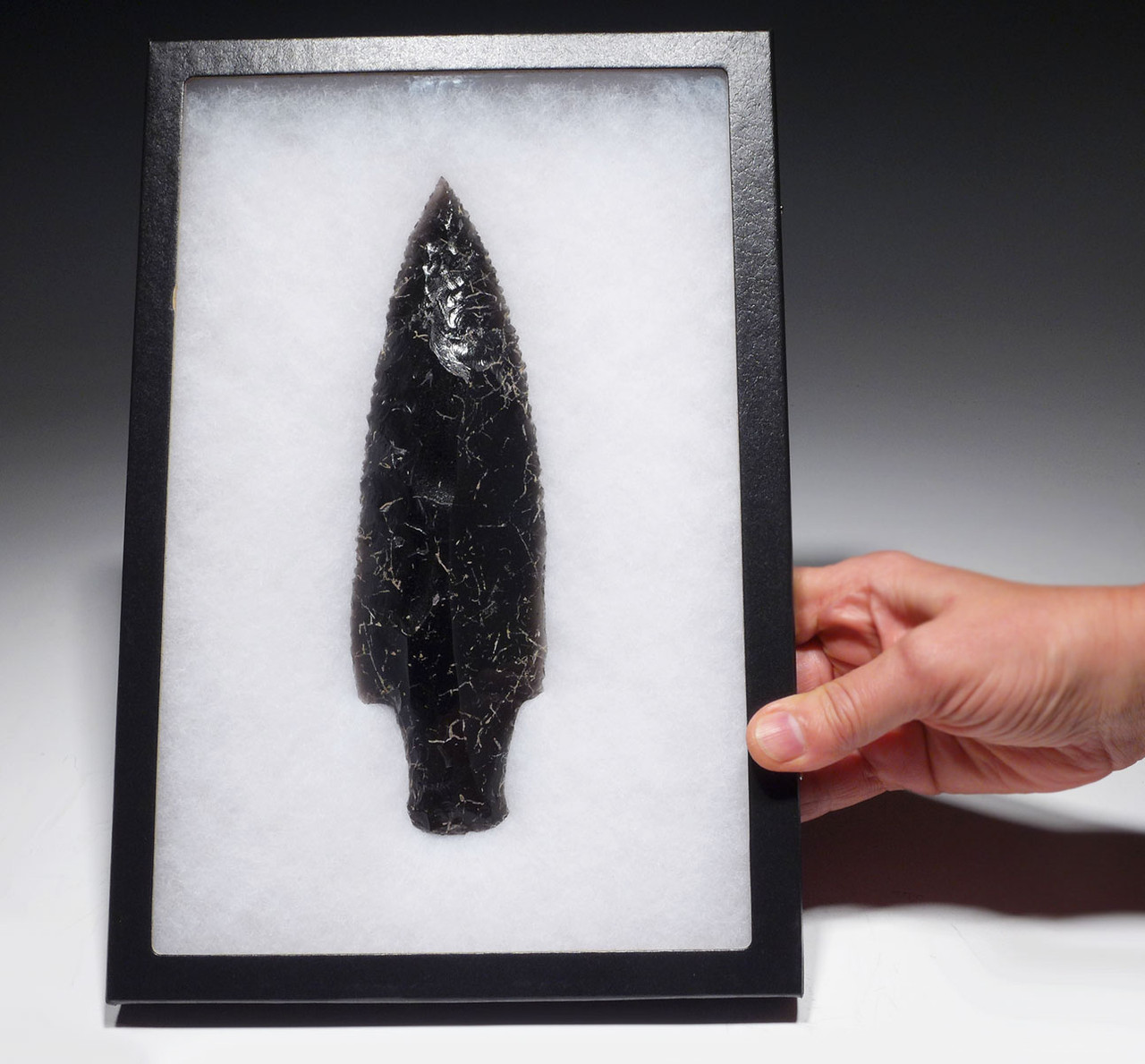Product Description
SEE MORE PRE-COLUMBIAN ARTIFACTS
Unique to the Pre-Columbian Mayans were the iconic macro blade weapons they flaked out of stone. While many stone tools were similar throughout the world, the stemmed macro blade dagger was totally unique to the Maya, and date back as early as 250 B.C.. These large daggers were flaked entirely from a single, massive core-struck unifacial flake, later worked to have an integral knapped handle, and a long triangular blade with a pointed tip. For the first time in 24 years of extensive experience with Pre-Columbian material, we see this macro blade technology used in a different dagger typology. This unusual specimen shows a short tang, with the intention to haft the blade onto a separate handle. Additional features that are rare and unusual include: 1) it is made of obsidian (not the typical chert), 2) it is dramatically serrated, and 3) it has been bifacially flaked as opposed to the typical unifacial form. The level of flaking skill used, and the detail of meticulous workmanship down to the needle-sharp undamaged tip, far exceeds the quality of ordinary weapons intended for use in normal combat. All the features of this unusual massive dagger blade strongly suggest this was a weapon used in ceremonial human sacrifice, to cut through a rib cage to extract a heart, for cutting through neck vertebra for ritual decapitation sacrifice, or to cut through heavy tendon and bone in the dismemberment of the victim after they were killed, often for distribution and consumption of body parts to the elites.
The majority of bifacial daggers used in human sacrifice had sharp straight cutting edges. A dagger that had large serrations would have been needed to cut and saw through bone and ligaments, something an ordinary straight edge blade could not do. Obsidian yielded the sharpest blade edge, having the unique physical property of being able to be flaked to an edge of only a single molecule. This is reason why obsidian blades are still used today in some modern medical surgery applications. A dagger like this would have been an important tool / weapon of a Mayan high priest to perform ALL aspects of human sacrifice rituals. From the Dr. Medina Pre-Columbian collection dating to the 1950's, of which a notarized acquisition letter and documentation will be provided to the buyer.
This MUSEUM-CLASS Mayan obsidian serrated macro blade dagger is THE ONLY ONE OF ITS KIND WE HAVE SEEN OR KNOW OF! The ancient flaking throughout is remarkable, achieving incredible intact sharpness to the dramatically serrated cutting edges and perfectly sharp, undamaged tip. The entire surface of the obsidian shows an ancient spiderweb pattern of calcite encrustations left behind by plant roots as this piece lay buried for over a thousand years. As irrefutable evidence of authenticity and an unaltered, original state, the entire surface features original deposits and minerals impacted deep in all the flake scars and micro-crevices of the stone.
HISTORY
 Of all the ancient cultures of the Americas, no civilization has held more intrigue and secrets for so long as that of the Mayans. In 1960, their language code of glyphs was finally deciphered and forever changed our view of what we initially thought was a peaceful and harmonious society. On the contrary, the Mayan Culture of the latter years was bathed in the blood of vicious warfare and astounding levels of human sacrifice. Their technology was so advanced it is no wonder many believe they received intelligence from extra-terrestrials. Despite our recent discoveries of Mayan mathematics, astronomy and calendar technology, the Mayans still leave us with many mysteries. Their love of war caused them to manufacture spectacular weapons with inherent beauty and artistry. Their ceramics depict a fascinating culture of status, sacrifice and deep religious devotion to a number of strange gods.
Of all the ancient cultures of the Americas, no civilization has held more intrigue and secrets for so long as that of the Mayans. In 1960, their language code of glyphs was finally deciphered and forever changed our view of what we initially thought was a peaceful and harmonious society. On the contrary, the Mayan Culture of the latter years was bathed in the blood of vicious warfare and astounding levels of human sacrifice. Their technology was so advanced it is no wonder many believe they received intelligence from extra-terrestrials. Despite our recent discoveries of Mayan mathematics, astronomy and calendar technology, the Mayans still leave us with many mysteries. Their love of war caused them to manufacture spectacular weapons with inherent beauty and artistry. Their ceramics depict a fascinating culture of status, sacrifice and deep religious devotion to a number of strange gods.
Archaeologists divide the Mayan Culture into different periods - LATE PRE-CLASSIC / PROTO-CLASSIC (300 BC - 300 AD), EARLY CLASSIC (300 AD - 600 AD), LATE CLASSIC (600 AD - 830 AD), TERMINAL CLASSIC (830 AD - 950 AD). The earliest days of the Maya date back to 2000 BC when small farming villages first appeared in the highlands and Pacific coastline of Guatemala. Crops such as corn, squash and beans made up the staple of their diet and are believed to have been brought from previous migration through Mexico. The Maya pottery styles were unique to the early Maya settlements, though. By 1000 BC, villages sprang up in the lowland regions. The Maya lived in the same locations for centuries and in a continuous state of architectural improvement and expansion leading up to the magnificent 'super-cities' we associate with them today. By 300 AD. full-scale cities were being built with stone featuring massive plazas, temples and pyramids reaching 20 stories high.
Human sacrifice in Maya culture was the ritual offering of nourishment to the gods and goddesses. Blood was viewed as a potent source of nourishment for the Maya deities, and the sacrifice of a living creature was a powerful blood offering. By extension, the sacrifice of human life was the ultimate offering of blood to the gods, and the most important Maya rituals culminated in human sacrifice. Generally, only high-status prisoners of war were sacrificed, and lower status captives were used for labor.
Human sacrifice among the Maya is evident from at least the Classic period (c. AD 250–900) right through to the final stages of the Spanish conquest in the 17th century. Human sacrifice is depicted in Classic Maya art, is mentioned in Classic period glyph texts and has been verified archaeologically by analysis of skeletal remains from the Classic and Postclassic (c. AD 900–1524) periods. Additionally, human sacrifice is described in a number of late Maya and early Spanish colonial texts, including the Madrid Codex, the Kʼicheʼ epic Popol Vuh, the Kʼicheʼ Título de Totonicapán, the Kʼicheʼ language Rabinal Achi, the Annals of the Kaqchikels, the Yucatec Songs of Dzitbalche and Diego de Landa's Relación de las cosas de Yucatán.
Important rituals such as the dedication of major building projects or the enthronement of a new ruler required a human sacrificial offering. The sacrifice of an enemy king was the most prized offering, and such a sacrifice involved the decapitation of the captive ruler in a ritual reenactment of the decapitation of the Maya maize god by the Maya death gods. Sacrifice by decapitation is depicted in Classic period Maya art, and sometimes took place after the victim was tortured, being variously beaten, scalped, burnt or disembowelled. Sacrifice by decapitation is depicted on reliefs at Chichen Itza in two of the ballcourts (the Great Ballcourt and the Monjas Ballcourt).
Heart extractions and sacrifice have been viewed as a “supreme religious expression among the ancient Maya". The removal of the still-beating heart, or sometimes self-immolation, was considered a great offering and meal for the gods. It began with a dispersal of blood extracted either, from the mouth, nose, ears, fingers, or penis, typically with a sharp tool made from animal bone, such as a stingray spine. The victim would then be positioned on a stone or wooden altar, and access to the heart would be achieved with a variety of procedures and techniques. Most of these techniques were proved by examination of the post-mortem injuries on bones surrounding the heart, such as the sternum, and ribs. Methods include vertical axial sternotomy, left transverse thoracotomy, transverse bilateral sternothoracotamy, or transdiaphragmatic access. The preferred method was most probably from below the diaphragm, as this allowed for easy access and not much blockage from bones (nicks, segmenting, and fracturing of the sternum and ribs indicate this). After which, the heart was exposed to retrieval. If accessed through the sternum, the ribs would be cut and pulled apart, or if via the diaphragm, tissue would be cut. The actual removal of the heart was achieved by cutting the attaching ligaments with a bifacial tool. Finally, offering of the heart would take place with either special positioning or through burning. At this time, blood would also be collected from the victim. The ritual will end with mutilation of the body, usually through dismemberment, or burned. They would then dispose of the body or re-utilize it for other purposes.
References:
- Fiedel, Stuart J., Prehistory of the Americas, 1992 - Freeman and Company, Early Man in America, 1973
- Hirth Kenneth, Obsidian Craft Production in Ancient Central Mexico, 2006
- Muser, Curt, Facts and Artifacts of Ancient Middle America, 1978
- Phillips, Charles, The Complete Illustrated History of the Aztec and Maya, 2008
- Tiesler, Vera; Cucina, Andrea (20 January 2017). "Procedures in Human Heart Extraction and Ritual Meaning: A Taphonomic Assessment of Anthropogenic Marks in Classic Maya Skeletons". Latin American Antiquity (17)
- Moser, Christopher L. (1973). "Human decapitation in ancient Mesoamerica". Studies in Pre-Columbian Art and Archaeology (11)
 US DOLLAR
US DOLLAR
 EURO
EURO
 AUSTRALIAN DOLLAR
AUSTRALIAN DOLLAR
 CANADIAN DOLLAR
CANADIAN DOLLAR
 POUND STERLING
POUND STERLING

























